

Photos and words by Bob Bross
Almost like clockwork, Dry Dredgers visit this Southeast Indiana site every two years. Over time, it has produced many fine Ordovician specimens, exciting to both experienced and first-time paleontologists. You KNOW it’s a good site when professionals and educators go there also (more on that in a moment.)
This was the first official outdoor field trip for our group of 2020, due to COVID-19. The nice thing about this location is its size; there was plenty of room to maintain desired social distancing. The sun was out, the temperature in the low 70’s, and it did not rain – perfect conditions for exploring!
Approximately 30 people ventured out on this fine day; for several of them, it was their first field trip ever! All ages, from grade school through those in their 70’s, all made nice finds throughout the day. Due to constant erosion, larger complete fossils are difficult to find; however, patience – and a careful eye – will find something worth bringing home.
Fossils Found That Day
One of the best finds of the day was a small bed of crinoid calyxes. Usually, one finds just the stems; however, this individual carefully worked a one-square foot area and discovered multiple calyxes – and a holdfast as well.
The best crinoid find was this nice Plicodendocrinus casei with a complete anal sac preserved. This anal sac is a chimney that allows disposal of waste away from its feeding structures. (next 2 pictures)
And a member found a very interesting crinoid stem that apparently had been damaged and is attempting to regenerate either a calyx (head) or holdfast (footing). The crinoid species is Cincinnaticrinus pentagonus.
Here's a find that gets your blood flowing. It is a hash of
trlobite parts and crinoid calyx parts. What could be more exciting except whole
ones. 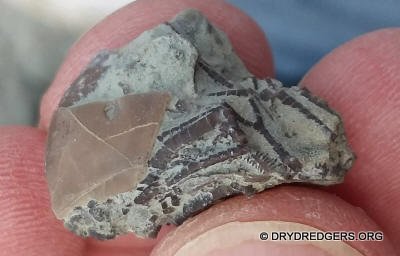
The specimen at right in the photo below is a crinoid stem.
But what is going on in the middle of that stem? Looks like a discussion for our
new Facebook group.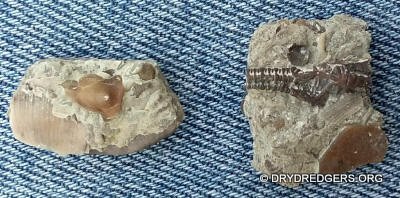
Brachiopods were plentiful, but few photos were taken as most were eager to show off their trilobites, gastropods, and large horn corals.
Trilobites
In the picture above, the specimen in the left is a hypostome (mouth plate) of a trilobite and may make it the best trilobite fossil find of the day.
There were a number of good finds of Flexicalymene trilobites.
Here is a couple. 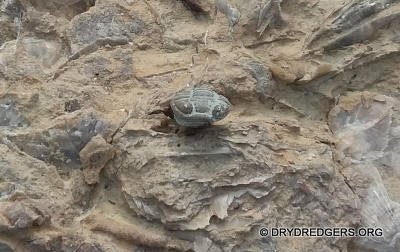
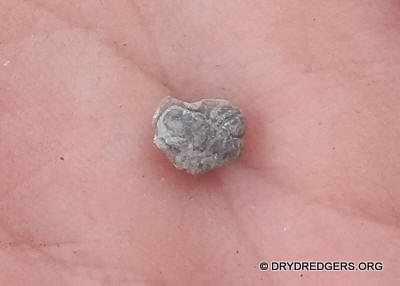
The hash fossil material in the next picture includes
fragments of several trilobite types. Notice the tiny spines near the center of
the rock and the genal spine below it that has bumps on it. These may be from
the spiny trilobite Acidaspis.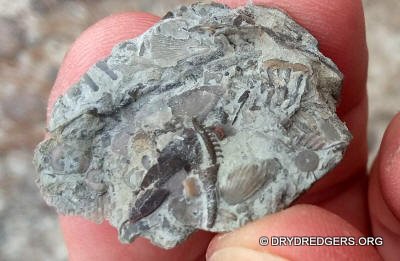
Bunches of Isotelus
trilobite fragments were found all in one spot. These are likely to
have come from one single specimen that had fallen apart and weathered. It's
rare to find a whole Isotelus trilobite but very
common to find lots of fragments like this.
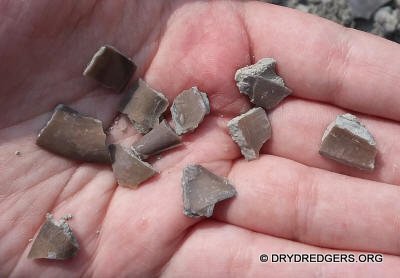
Here's a nice example of an Isotelus
genal spine.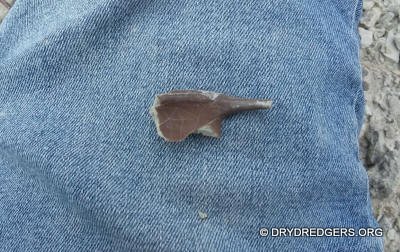
Trilobite pieces are often found in fossil hash - a shell bed
assemblage of many fossil types. In the rock below, the red object is hard to
identify, but is probably a fragment of Isotelus
trilobite stained by iron deposits. A brown example of an Isotelus fragment
is to the right of it, laying against a large brachiopod of the genus
Vinlandostrophia.
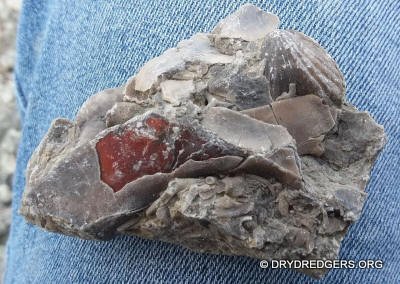
Brachiopods
It is possible to find more than a dozen species of
brachiopods on this site. This is the only one for which I have a photograph.
It's the beautiful brachiopod Leptaena
richmondensis.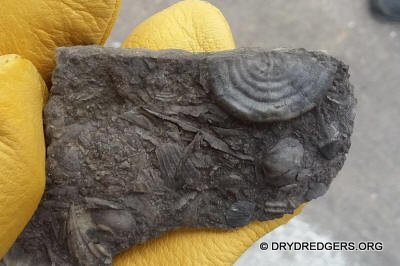
Corals
The most common type of coral found was the solitary coral or
"Horn Coral." The species on the horn coral in the next 2 pictures is likely
Grewingkia canadensis.
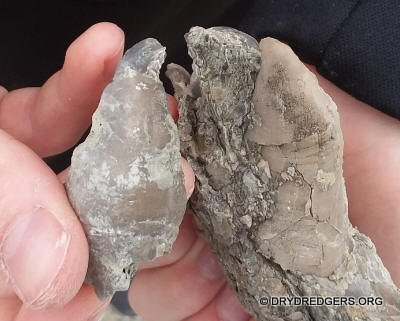
The other type of coral found was colonial coral. The next 2
pictures show a tabulate coral, both sides. It looks like this coral may have
been encrusting a nautiloid cephalopod but the cephalopod was not preserved.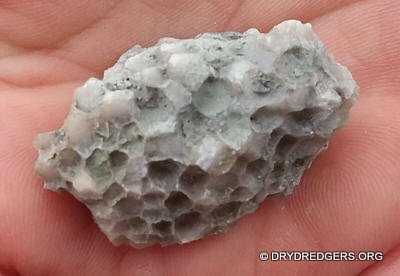

Gastropods (snails)
We saw gastropod layers that were loaded with these snails.
Here's one slab that demonstrates how plentiful the snails are in this layer.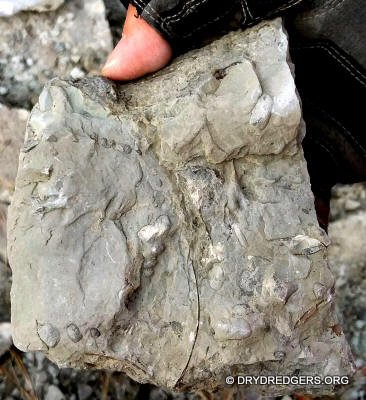
Another member brought several plates found over the summer at
a different location. Notice the inverted trilobite at the top of the photo;
that, and a small portion of an edrioasteroid were all that was visible
initially. When cleaning began later at home, more details began to emerge, and
that person quickly decided to seek a professional assistance. Some will recall
the several visits Dry Dredgers have visited the Cooper family fossil prep lab.
This is the result: multiple Edrioasteroids!


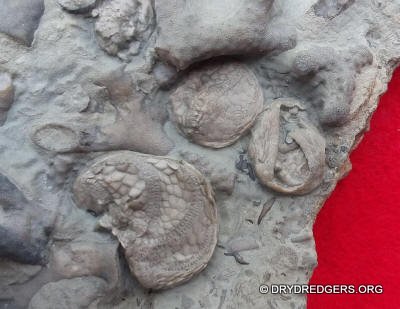

As lunchtime approached, some people began to pack up and head
home; then, several vans pulled up and numerous college students began to
emerge, let by our own advisor Dr. Carl Brett. He was told there was a “nice
display” at a nearby car, and Carl decided to take a look. “What have we hear?
OH MY. This is beautiful!” He called his students over to see the multiple
plates of Edrioasteroids, and other Dry Dredgers began showing their finds of
the day. 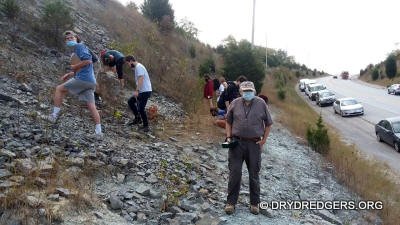
Great weather, great location, great friends, great finds; overall, a great day for paleontology.
That's all. Join us in October 24, 2020 for our next field trip.
See previous field trips to this Southeast Indiana fossil mecca.
April 2019
October 2017
March 2016
March 2015
March 2014
April 2013
April 2012
May 2011
March 2010
September 2008
September 2007
September 2006
March 2006
March 2004
October 2003
April 2002
Back to the Field Trip Index Page
Return to Dry Dredgers Home Page
The Dry Dredgers and individual contributors reserve the rights
to all information, images, and content presented here. Permission to reproduce
in any fashion, must be requested in writing to
admin@drydredgers.org.
www.drydredgers.org
is designed and maintained by Bill Heimbrock.